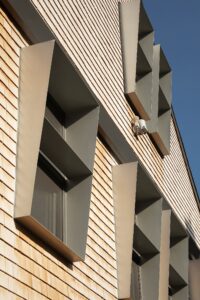NEW MILESTONES FOR HARVARD HOUSEZERO™: LATEST RESEARCH VALIDATES CONTINUING HIGH-ENERGY EFFICIENCY, AND ACCESSIBLE REAL-TIME BUILDING PERFORMANCE DATA IS NOW LIVE ONLINE
Paper advances new framework for improving buildings’ total energy efficiency

CAMBRIDGE, MASS., October 30, 2023 – Continuing to support global building operations aimed at achieving ultra-low-energy goals, the engineering-architecture team from the Harvard Center for Green Buildings and Cities (CGBC), Skanska Technology, and Snøhetta is proposing a new data-informed building energy management(DiBEM) framework that promises to consistently and significantly improve energy efficiency throughout all integral building systems, according to a newly-published research journal article.
“As the global building sector strives to develop improvements that reduce greenhouse gas (GHG) emissions, precisely tracking every aspect of energy efficiency is critical, not just at the start of each intervention, but also through a building’s continuous operation. Our desire is to inform users of their influence on energy use and, where possible, stimulate positive behavior through design,” said representatives from Snøhetta, the international architecture and design company whose architectural work supported the paper now featured in the international journal Energy & Buildings.
Using HouseZero™, the 356 m² (or 3,832-square foot) former Cambridge single-family residence now transformed into a living laboratory, as its test subject, the research team reveals that through live-performance monitoring and other analytics, data can inform both the development and continuous improvement of potential energy saving controls and operations.

“This comprehensive framework, developed through HouseZero™, shows its potential to save energy in buildings,” said the research team from the Harvard CGBC. “The framework is relatively simple to apply to building operations and offers a semi-automatic solution to improving energy efficiency. We aim to advance knowledge and methods, helping the building community improve and achieve higher levels of energy efficiency.”
In demonstrating the HouseZero-inspired framework, researchers also are highlighting its ultra-energy-efficient second operating year, as total energy-use intensity decreased from the already ultra-low 54.1 kWh/m2 in year one to 42.8 kWh/m2 in year two (20.89% decrease between year one and year two). This performance data is now, for the first time, included in a live dashboardthat provides a 24/7, real-time summary of a wide range of performance data, along with related graphics.
“As reported in our paper, energy consumption in Year Two of HouseZero™was further reduced, particularly through hardware retrofitting, improvements to our controls and operations settings, and energy-saving occupant behavioral changes, such as reducing equipment use and electric lighting when applicable,” explained the Norwegian-based engineering team at Skanska Technology (Norway). “Even as occupancy of the building increases amid easing COVID-19 restrictions, HouseZero™ continues to demonstrate its ultra-low energy performance.”

The live data dashboard provides a snapshot of how the building is performing in order to educate others about green buildings and promote greater understanding of building performance.
Co-authors of the publication “Data-Informed Building Energy Management (DiBEM) towards Ultra-Low Energy Buildings” include CGBC researchers, Jung Min Han, Sunghwan Lim, Ali Malkawi, Xu Han, Elence Xinzhu Chen, and Shide Salimi, Skanska Technology researcher, Tor Helge Dokka, The Oslo School of Architecture and Design Professor Tine Hegli (formerly of Snøhetta) and Snøhetta architect Kristian Edwards. Snøhetta was the architectural lead on HouseZero, and Skanska Technology directed all engineering facets. Read the full publication.
Key Findings:
- Energy-efficient building operation requires the integration of various strategies for different building subsystems and a continuous effort throughout a building’s operation stage.
- A data-informed building energy management framework (DiBEM) was proposed to continuously improve energy efficiency throughout a building’s operation stage through data and models.
- In using HouseZero™ as a case study for this framework, it successfully exhibited improved energy efficiency. Through identifying and implementing interventions related to heating and cooling, domestic hot water, lighting, and IT plug load, HouseZero was able to reduce its energy use in its second operating year.
- The result showed that the total energy use intensity (EUI) was reduced from 54.1 kWh/m2 in the first year to 42.8 kWh/m2 in the second year, where 5.4 kWh/m2 was estimated to be contributed by the interventions, as also described in the summary report of HouseZero’s second year energy use.
- A comprehensive energy benchmarking analysis was conducted by comparing its Year One and Year Two energy use with different references, including databases, standards, design guides, and energy targets from different institutes. HouseZero continues to exceed these milestones.
